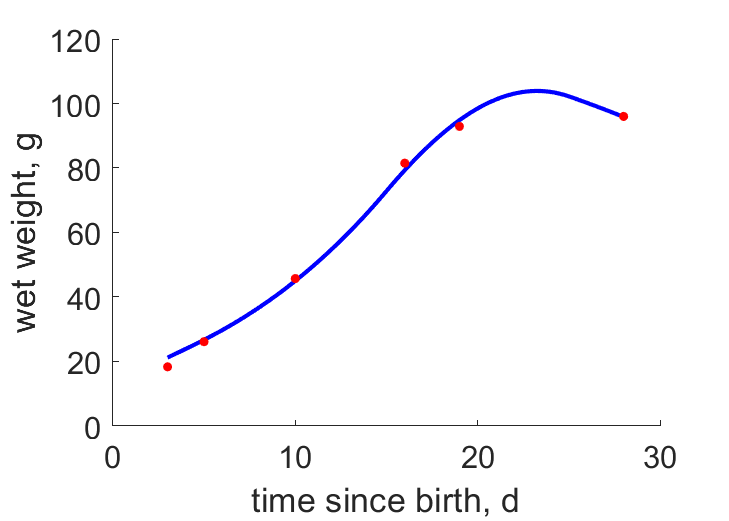Predictions & Data for this entry
| Model: std | climate: BSk, Cwa, Cwb | migrate: | phylum: |
| COMPLETE = 2.5 | ecozone: THn | food: biCi, biCvr, xiHs | class: |
| MRE = 0.022 | habitat: 0iTf | gender: Dg | order: |
| SMSE = 0.001 | embryo: Tnwfm | reprod: O | family: |
Zero-variate data
| Data | Observed | Predicted | (RE) | Unit | Description | Reference |
|---|---|---|---|---|---|---|
| ab | 22 | 23.3 | (0.05916) | d | age at birth | GonzCruz2008 |
| tx | 30 | 30 | (0.000129) | d | time since birth at fledging | GonzCruz2008 |
| tp | 90 | 86.48 | (0.03914) | d | time since birth at puberty | guess |
| tR | 1825 | 1825 | ( 0) | d | time since birth at 1st brood | AZ_Anim |
| am | 9125 | 9156 | (0.003416) | d | life span | AZ_Anim |
| Li | 34.5 | 34.53 | (0.0008473) | cm | ultimate total length | Will1992 |
| Wwb | 14.5 | 13.79 | (0.04898) | g | wet weight at birth | Orel2004 |
| Wwi | 130.2 | 135.4 | (0.03938) | g | ultimate wet weight | avibase |
| Wwim | 115.5 | 115.4 | (0.0009886) | g | ultimate wet weight male | avibase |
| Ri | 0.005479 | 0.005375 | (0.01898) | #/d | maximum reprod rate | Planet |
Uni- and bivariate data
| Data | Figure | Independent variable | Dependent variable | (RE) | Reference |
|---|---|---|---|---|---|
| tW |  | time since birth | wet weight | (0.02354) | GonzCruz2008 |
Pseudo-data at Tref = 20°C
| Data | Generalised animal | Euptilotis neoxenus | Unit | Description |
|---|---|---|---|---|
| v | 0.02 | 0.02842 | cm/d | energy conductance |
| p_M | 18 | 1185 | J/d.cm^3 | vol-spec som maint |
| k_J | 0.002 | 0.04863 | 1/d | maturity maint rate coefficient |
| k | 0.3 | 0.3005 | - | maintenance ratio |
| kap | 0.8 | 0.9246 | - | allocation fraction to soma |
| kap_G | 0.8 | 0.8004 | - | growth efficiency |
| kap_R | 0.95 | 0.95 | - | reproduction efficiency |
Discussion
- high age at first reproduction cannot be captured by the std model
- mod_3: v is reduced
- mod_3: males are assumed to differ from females by {p_Am} only
- mod_4: Pseudo-data point k is used, rather than k_J; Data set tp and parameter t_R are added, the latter replacing clutch interval t_N. Postnatal T is based on PrinPres1991, see get_T_Aves. See further the revision page, theme puberty
Bibliography